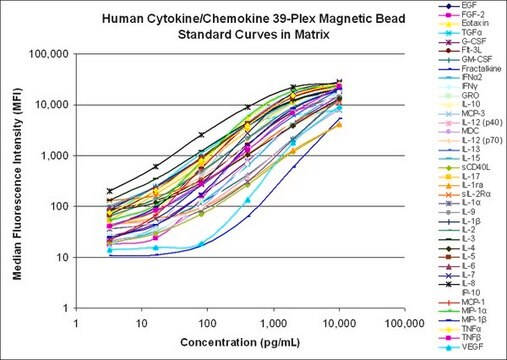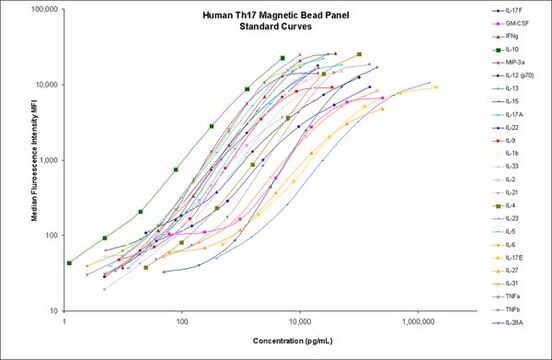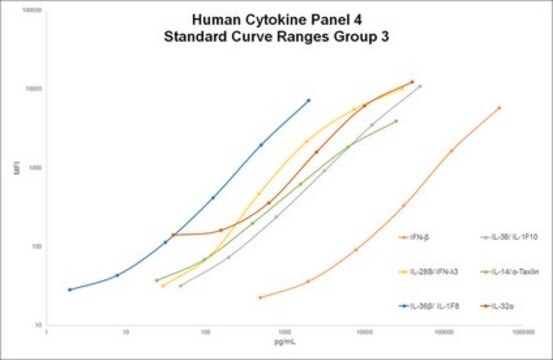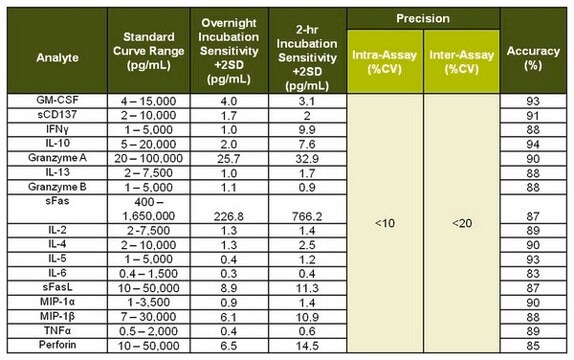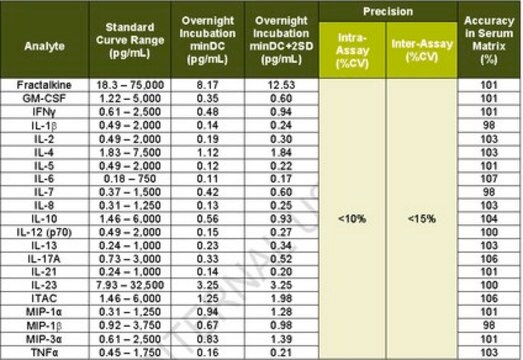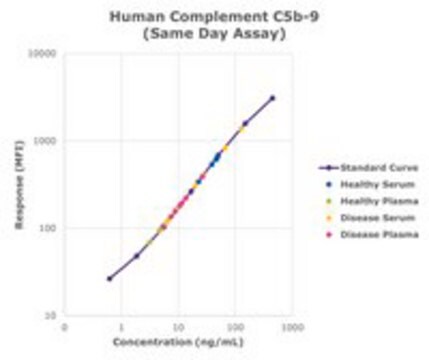HCD8MAG-15K
MILLIPLEX® Human CD8+ T Cell Magnetic Bead Panel - Immunology Multiplex Assay
Simultaneously analyze multiple cytokine and chemokine biomarkers with Bead-Based Multiplex Assays using the Luminex technology, in human serum, plasma and cell culture samples.
Synonym(e):
Human CD8 T cell cytokine panel, Human cytokine multiplex kit, Luminex® human cytokine immunoassay, Millipore human cytokine panel
About This Item
Empfohlene Produkte
Qualitätsniveau
Speziesreaktivität
human
Hersteller/Markenname
Milliplex®
assay range
standard curve range: 0.4-1,500 pg/mL
(IL-6)
standard curve range: 0.5-2,000 pg/mL
(TNFα)
standard curve range: 1-3,500 pg/mL
(MIP-1α)
standard curve range: 1-5,000 pg/mL
(Granzyme B)
standard curve range: 1-5,000 pg/mL
(IFNγ)
standard curve range: 1-5,000 pg/mL
(IL-5)
standard curve range: 10-50,000 pg/mL
(Perforin)
standard curve range: 10-50,000 pg/mL
(sFasL)
standard curve range: 2-10,000 pg/mL
(IL-4)
standard curve range: 2-10,000 pg/mL
(sCD137)
standard curve range: 2-7,500 pg/mL
(IL-13)
standard curve range: 2-7,500 pg/mL
(IL-2)
standard curve range: 20-100,000 pg/mL
(Granzyme A)
standard curve range: 4-15,000 pg/mL
(GM-CSF)
standard curve range: 400-1,650,000 pg/mL
(sFas)
standard curve range: 5-20,000 pg/mL
(IL-10)
standard curve range: 7-30,000 pg/mL
(MIP-1β)
Methode(n)
multiplexing: suitable
Nachweisverfahren
fluorometric (Luminex xMAP)
Versandbedingung
wet ice
Verwandte Kategorien
Allgemeine Beschreibung
The Luminex® xMAP® platform uses a magnetic bead immunoassay format for ideal speed and sensitivity to quantitate multiple analytes simultaneously, dramatically improving productivity while conserving valuable sample volume.
Panel Type: Cytokines/Chemokines
Spezifität
Anwendung
- Analytes: GM-CSF, sCD137, IFNγ, sFas, sFasL, Granzyme A, Granzyme B, IL-2, IL-4, IL-5, IL-6, IL-10, IL-13, MIP-1α, MIP-1β, TNF-α, Perforin
- Recommended Sample type: serum, plasma or tissue/cell lysate and culture supernatant
- Recommended Sample dilution: Neat
- Assay Run Time: Overnight
- Research Category Inflammation & Immunology
Leistungsmerkmale und Vorteile
Lagerung und Haltbarkeit
Sonstige Hinweise
Rechtliche Hinweise
Haftungsausschluss
Signalwort
Danger
Gefahreneinstufungen
Acute Tox. 4 Dermal - Acute Tox. 4 Inhalation - Acute Tox. 4 Oral - Aquatic Chronic 2 - Eye Dam. 1 - Skin Sens. 1 - STOT RE 2
Zielorgane
Respiratory Tract
Lagerklassenschlüssel
10 - Combustible liquids
WGK
WGK 3
Analysenzertifikate (COA)
Suchen Sie nach Analysenzertifikate (COA), indem Sie die Lot-/Chargennummer des Produkts eingeben. Lot- und Chargennummern sind auf dem Produktetikett hinter den Wörtern ‘Lot’ oder ‘Batch’ (Lot oder Charge) zu finden.
Besitzen Sie dieses Produkt bereits?
In der Dokumentenbibliothek finden Sie die Dokumentation zu den Produkten, die Sie kürzlich erworben haben.
Unser Team von Wissenschaftlern verfügt über Erfahrung in allen Forschungsbereichen einschließlich Life Science, Materialwissenschaften, chemischer Synthese, Chromatographie, Analytik und vielen mehr..
Setzen Sie sich mit dem technischen Dienst in Verbindung.
